Learning a new language can be an exciting journey filled with the discovery of nuances and subtleties that make each language unique. One such example is the difference between the Ukrainian words “зашморг” and “петля.” While both might translate to “noose” and “loop” respectively, their usage and connotations can vary significantly. In this article, we will delve into these two words, examining their meanings, contexts, and why it’s essential to understand their distinctions.
Understanding “Зашморг” (Noose)
The word “зашморг” (zashmorh) in Ukrainian is typically translated to “noose” in English. A noose is a loop with a running knot that tightens as the rope or cord is pulled. The word carries strong connotations and is often associated with negative or dark imagery.
Context and Usage:
1. **Historical and Cultural Significance**: Historically, the noose has been associated with execution methods, particularly hanging. This association is deeply rooted in many cultures, and Ukraine is no exception. The word “зашморг” can evoke images of historical events, punishments, and even literary references to executions or suicides.
2. **Modern Usage**: In contemporary Ukrainian, “зашморг” is not commonly used in everyday conversation due to its heavy connotations. It might appear in literature, historical discussions, or when discussing specific topics related to crime, punishment, or metaphorical expressions of entrapment or despair.
3. **Metaphorical Use**: Like in English, where one might say “putting a noose around someone’s neck” to imply trapping or putting someone in a difficult situation, “зашморг” can be used metaphorically in Ukrainian. For instance, one might say, “Він відчуває, що на його шиї затягується зашморг,” which translates to “He feels the noose tightening around his neck,” indicating increasing pressure or trouble.
Examples in Sentences:
1. “Злочинець був засуджений до смертної кари через повішення на зашморгу.”
– “The criminal was sentenced to death by hanging from a noose.”
2. “Іноді життя здається мені, ніби зашморг затягується все тугіше.”
– “Sometimes life feels to me like the noose is tightening ever more.”
Understanding “Петля” (Loop)
In contrast, the word “петля” (petlya) translates to “loop” in English. A loop is a shape produced by a curve that bends around and crosses itself. The word “петля” is much more versatile and generally carries neutral or less intense connotations compared to “зашморг.”
Context and Usage:
1. **Everyday Language**: “Петля” is commonly used in everyday conversation and can refer to various loops and loops in different contexts. For example, it can describe loops in knitting, loops in a road, or even loops in logic or programming.
2. **Technical and Practical Uses**: In technical fields, “петля” might be used to describe specific types of loops, such as feedback loops in engineering, electrical loops, or loops in computer programming. Its application in these fields is purely functional and devoid of any heavy or negative connotations.
3. **Metaphorical Use**: While “петля” is less likely to be used in a metaphorical sense compared to “зашморг,” it can still appear in expressions. For example, one might say, “Життя іноді робить дивні петлі,” which translates to “Life sometimes makes strange loops,” implying unexpected twists and turns.
Examples in Sentences:
1. “Для створення цього візерунка потрібно зробити кілька петель.”
– “To create this pattern, you need to make several loops.”
2. “Дорога робить круту петлю навколо гори.”
– “The road makes a sharp loop around the mountain.”
Key Differences and Why They Matter
Understanding the differences between “зашморг” and “петля” is crucial for several reasons:
1. **Connotation and Tone**: As discussed, “зашморг” carries much stronger, often negative connotations compared to the neutral and versatile “петля.” Using the wrong word in a particular context can drastically change the tone and meaning of your sentence.
2. **Context Appropriateness**: Knowing when to use each word appropriately is essential. For example, using “зашморг” when referring to a simple loop in knitting would be incorrect and might confuse or disturb the listener.
3. **Cultural Sensitivity**: Language learners must be aware of the cultural and historical significance of words. Misusing a word like “зашморг” can be seen as insensitive or inappropriate in certain contexts, especially given its association with execution and suicide.
Comparing with English Counterparts
To further illustrate the importance of understanding these distinctions, let’s compare with their English counterparts:
1. **Noose (Зашморг)**:
– In English, “noose” also carries heavy connotations, often related to execution or suicide. It’s not a word used lightly or in casual conversation.
– Example: “The noose was found at the crime scene,” implies a serious and possibly tragic context.
2. **Loop (Петля)**:
– “Loop” in English is versatile and used in various contexts, from describing shapes to technical terms in programming.
– Example: “The road loops around the park,” is a simple, neutral description of the road’s path.
Common Mistakes and How to Avoid Them
Language learners often make mistakes when dealing with words that have similar translations but different connotations. Here are some common mistakes and tips to avoid them:
1. **Using “зашморг” instead of “петля”**:
– Mistake: “Я зробив зашморг з мотузки для в’язання.”
– Correction: “Я зробив петлю з мотузки для в’язання.”
– Tip: Remember that “зашморг” is specific to nooses and carries heavy connotations. For general loops, use “петля.”
2. **Using “петля” in metaphorical contexts where “зашморг” is more appropriate**:
– Mistake: “Він відчуває, що на його шиї затягується петля.”
– Correction: “Він відчуває, що на його шиї затягується зашморг.”
– Tip: When discussing metaphorical situations involving entrapment or severe pressure, “зашморг” is more appropriate.
Practice Exercises
To help solidify your understanding of these words, here are some practice exercises:
1. **Translation Practice**:
– Translate the following sentences into Ukrainian, choosing between “зашморг” and “петля”:
a. “The programmer fixed the error in the loop.”
b. “The prisoner felt the noose tightening around his neck.”
c. “She made a loop with the ribbon to decorate the gift.”
2. **Contextual Understanding**:
– Read the following sentences and identify if the usage of “зашморг” or “петля” is correct. If not, correct it:
a. “Він зробив зашморг, щоб підвісити картину на стіну.”
b. “На конкурсі з плетіння вона зробила найкращу петлю.”
3. **Creative Writing**:
– Write a short paragraph (3-4 sentences) using both “зашморг” and “петля” correctly in different contexts.
Conclusion
Mastering the subtleties of a language involves understanding not just direct translations but also the connotations and appropriate contexts for words. The Ukrainian words “зашморг” and “петля” offer an excellent example of this complexity. By understanding the differences between a noose and a loop, language learners can enhance their communication skills, avoid misunderstandings, and show greater cultural sensitivity. Happy learning!

